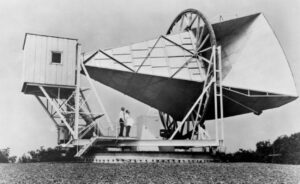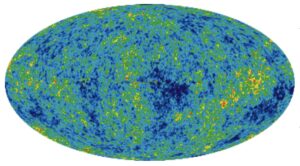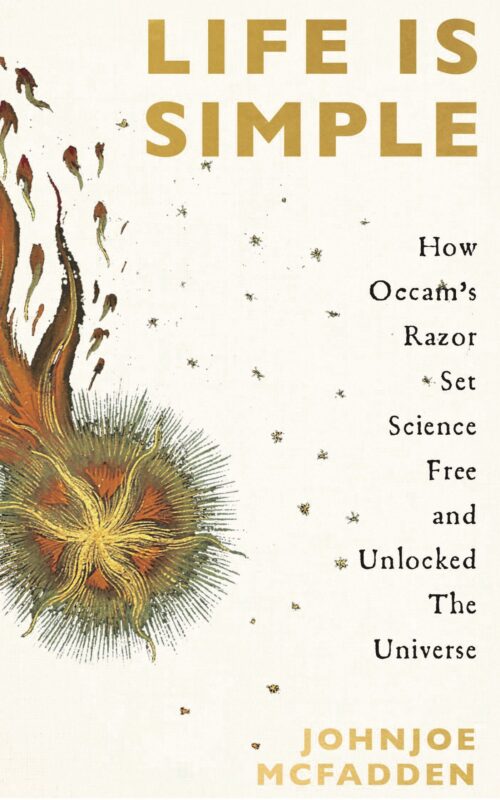Biologist & Writer

Life is Simple: How Occam’s Razor Set Science Free and Unlocked the Universe. (2021)
Published by Basic Books in the UK on 2 September (hachette.co.uk) and in the US on 28 September (Amazon US)
Meet the unsung hero of our modern world: a fourteenth century friar, William of Occam. He first articulated the principle that the best answer to any problem is the simplest. This theory, known as Occam’s razor, cut through the thickets of medieval metaphysics, theology and mysticism to clear a path for modern science.
We follow the razor in the hands of the giants of science, from Copernicus, to Kepler, Galileo, Newton, Darwin, Einstein, Rubin and Higgs. Its success suggests that we live in the simplest possible habitable universe and supports the revolutionary theory that our cosmos has evolved.
By highlighting the very human passion, curiosity, mistakes and struggles of those who were inspired by Occam’s razor to create the modern world, Life is Simple provides new insight into what science is really about. And that the principle of simplicity is as relevant today as ever.

Reviews
“For all its technical triumphs, science does not take place in a cultural vacuum. McFadden’s wonderful and thoroughly-researched account of the history of ideas reveals how simplicity as an overarching principle weaves through all the sciences, telling us something profound about the nature of reality. His vivid descriptions and clear exposition make the subject come alive, and resonate with significance. This is one of the best science books I have read in a decade.” — Paul Davies, Regents’ Professor of Physics at Arizona State University and author of What’s Eating the Universe?
LIFE IS SIMPLE tells, in an entertaining and engaging way, the remarkable story of a simple idea that begins its epic journey 800 years ago with a medieval Franciscan friar and yet somehow still influences some of the most profound ideas in science today.”
Jim al-Khalili
“Occam’s razor, like Hobson’s choice and Schrödinger’s cat, is a phrase that’s entered the language. We know more or less what it means without necessarily knowing anything about its inventor or realising the immense power it has as a philosophical and scientific principle. LIFE IS SIMPLE describes brilliantly the context in which William of Occam lived and worked, and the transforming effect that his simple-seeming doctrine has had on the development of our understanding of nature and the universe.”
Philip Pullman
“I read LIFE IS SIMPLE and found myself captured by the central premise: that science, though perceived as complicated, is actually the pursuit of simplicity. Johnjoe has created a fascinating book that weaves history, science and humanity together to illuminate what science really is – a topic that could not be more timely. The world is currently waking up to the complexities of science and its role in our world, and this book is an enlightening aid to that new understanding.”
Michael Brooks, physicist and science writer
“The 14th-century Franciscan friar William of Occam saw the importance of finding the simplest explanation for any phenomenon—the principle known as Occam’s Razor. Johnjoe McFadden explores this revolutionary approach to how the brain apprehends a complex universe, and its consequences across human history.”―Wall Street Journal
“Like a talented stylist or editor, courageous scientists have identified what is redundant … and promptly scratched it out. McFadden’s book brings this observation to life using two millennia of scientific advancement, never castigating those who were wrong, but instead highlighting how they helped to shape the correct answers that came later.”
―Popular Mechanics
“In a conspiracy-laden world, McFadden’s argument, that simple explanations hold true, will appeal to historians and the scientifically minded.”
―Library Jounal
“Thoroughly fascinating . . . Far from being a narrow specialist, [McFadden] has a firm grasp of the complexities of many branches of science . . . Breath-taking in its comprehensiveness and clarity … These few pages of worthy of Walter Scott or Robert Louis Stevenson at their most vivid” — John Banville, Irish Times
“If you are at all interested in the history of ideas, this is a fabulous read. Even after you’ve taken a few detours through other material to become better oriented in the controversy over what exactly he’s good for, William plausibly still stands as a daring, original figure who deserves a place in the Pantheon, and McFadden has done a great service in bringing the whole William and his influence to wider attention.” In short, Life Is Simple is enthralling. ―Michael Blastland, Prospect (UK)
“The most sheerly enjoyable history of science of recent years.”―Simon Ings, The Spectator (UK)
“In LIFE IS SIMPLE, geneticist Johnjoe McFadden offers a breezy but well-researched look at how the razor has inspired some of science’s biggest ideas…his examples illustrate with persuasive power how ‘simplicity continues to present us with the most profound, enigmatic and sometimes unsettling insights’ into how the universe works.”
―Scientific American
“With flair and accessibility, McFadden walks readers through Occam’s many intellectually revolutionary ideas…A dense, provocative, and satisfying foray into the history of science.”―Kirkus Reviews
“A compelling assessment of an idea many of us know but few deeply understand.”―John Keogh, Booklist
“Recasting both the history of science and our universe’s origins, McFadden transforms our understanding of ourselves and our world.”―Irish Tech News (UK)
“I learned a great deal from reading this book and I thought that the concept of simplicity as the main plot of the story worked well. Instead of comparing the book to a work by a professional scientist, I think that the right comparison is to books written by scientists for a popular audience. I think that your book stacks up well against those kinds of books.”
Professor Bernard Lightman, Editor of ISIS, the leading History of Science journal. President of the History of Science Society, Fellow of the Royal Society of Canada
Sample From Introduction
Introduction

Figure 1: Bell Telephone Laboratories’ horn antenna in Holmdel, New Jersey, with Arno Penzias and Robert Wilson (1965). Photo courtesy of NASA
It is May 1964. Two American physicists stand beside a scientific instrument the size of a truck. The device, shaped like a giant ear trumpet, tops a low hillside above the small township of Holmdel in New Jersey. Both men are in their mid-thirties. Arno Penzias, born to a Bavarian Jewish family who fled to the Bronx in 1939, is tall and bespectacled with receding hair. Robert Woodrow Wilson from Houston, Texas, also tall, is dark-bearded and bald. The pair met at a conference only two years earlier. Penzias endlessly talkative, Wilson shy and tentative, hit it off. They joined forces at the world-famous Bell Laboratories to work on a project to map the stars with microwaves. Both stare at the sky. Both are baffled.
Microwaves, radiation with wavelengths anywhere between a millimetre and a metre, had been discovered nearly a century earlier and became a hot topic when Second World War military scientists attempted to harness them for radar, and tried to make rayguns capable of shooting down enemy missiles. After the war, telecommunication companies took an interest after the physicist Robert H. Dicke, working at the world-famous Massachusetts Institute of Technology (MIT), designed an efficient receiver capable of detecting microwaves. With both emitter and detector technology available, a new means of wireless communication was on the cards.
In 1959, Bell Laboratories built the Holmdel horn antenna to detect microwaves bounced off satellites. However, interest waned and shifted to alternative wireless communication technologies so Bell took to lending out the antenna to scientists who could make good use of a giant microwave trumpet. Penzias and Wilson planned to map the sky. On 20 May 1964 they climbed into the control room, a kind of elevated garden shed connected to the rear end of the trumpet, and pointed the antenna at the sky. Yet, wherever they looked, even when they aimed the giant antenna at dark regions of the night sky with very few stars, they detected only a low background noise, a static or hiss. The two men were baffled.
Their first guess was that it was some kind of interference from a local source of microwaves. They checked out, and eliminated, New York City, nuclear tests, a nearby military facility and atmospheric disturbances. Crawling inside their antenna, they even discovered a pair of roosting pigeons and suspected that their droppings might be the culprit. They set traps and cleaned up their droppings but, when the birds kept returning, the scientists resorted to shooting them. Even after the avian cull, wherever they pointed their instrument in the dark night sky, it continued to hiss, uniformly, back at them.
Princeton University is about an hour’s drive from Holmdel. After the war, Robert Dicke had moved there to teach and lead a research group focused on particle physics, lasers and cosmology. His lab specialised in developing sensitive instruments to test cosmological predictions of Einstein’s general theory of relativity. Cosmology was then being contested by two rival groups of theorists who vied to account for Edwin Hubble’s astonishing discovery, several decades earlier, that the universe is expanding. One camp favoured the steady-state theory, which claimed that the universe had always been expanding, balanced by a continuous creation of new matter into its spaces. The rival theorists, a group that included Dicke, took the expansion at its face value and ran it backwards in time to propose that, about 14 billion years ago, the universe must have burst into existence in a cataclysmic explosion from a very tiny point.
The problem was that it wasn’t easy to distinguish the rival theories as both made very similar predictions. Nevertheless, Dicke realised that an exploding universe should have left a kind of smoking cosmic gun as a uniform cloud of low energy microwave radiation. He recognised that the kind of radar detectors he had developed at MIT could be adapted to detect the cosmic energy cloud. The microwave radiation would however be very faint, far dimmer than any known radio or radar signal. Its detection would require a new generation of highly sensitive microwave detectors. Dicke and his Princeton group set out to build one.
Over the months and years, members of the group presented research talks describing their steady progress. A colleague of Penzias and Wilson attended one of these meetings and passed on news about the Princeton team’s efforts to the pair. Could the horn antenna’s persistent microwave hiss be the signal that Dicke was looking for? Penzias decided to give Robert Dicke a call. It came through when Dicke was having a ‘brown bag lunch’ meeting in his office at Princeton. His colleagues remember Dicke picking up the call and listening intently, occasionally, repeating phrases such as ‘horn antenna’ or ‘excess noise’ and nodding. Finally, putting down the receiver, he turned to his group and said, ‘Well boys, we’ve been scooped.’ Dicke realised that Penzias and Wilson had discovered the Big Bang.
The next day, Dicke and his team drove to the Bell laboratories, to admire the horn antenna and take closer look at the data. They returned convinced that Penzias and Wilson had indeed discovered the microwave remnant of the Big Bang. What most impressed both teams was the smoothness of the cosmic microwave background (CMB), as it was later called. It had, as far as they could tell, exactly the same intensity wherever they looked in the sky. Their discovery earned Penzias and Wilson the Nobel Prize in 1978. About a decade later, NASA launched their COBE satellite to provide more precise measurements and discovered faint ripples, with variations in radiation intensity of less than one part in 100 thousand, in the CBR. That is a lot less than the variation in whiteness you would see in the cleanest, whitest sheet of paper that you have ever seen. A decade later, in 1998, the European Space Agency (ESA), launched their own microwave detector into space, the Planck Space Observatory, and confirmed both the faint ripples and the extraordinary uniformity of the CMB.
The CMB is a kind of photograph taken of the universe when it was less than the size of the Milky Way. Its uniformity tells us that, at that moment, when the first blast of light emerged from its trillions of atoms, our universe was simple.

Figure 2: Cosmic microwave background. Image courtesy of NASA. http://map.gsfc.nasa.gov/media/121238/index.html
In fact, the CMB remains the simplest object that we know of today; simpler even than a single atom. It can be described by just a single number, 0.00001, which refers to the degree of variation in its ripple intensity. As Neil Turok, director of the Perimeter Institute for Theoretical Physics in Ontario, Canada, recently commented, the CBR tells us that ‘the universe turns out to be stunningly simple . . . [so much so that] we don’t know how nature got away with it.’
The universe remembers its simple beginnings so that, 14 billion years after the Big Bang, its bones remain simple. This book is about uncovering those bones – the fundamental building blocks of our universe – with a tool known as Occam’s razor, named after a Franciscan friar called William of Occam, who lived seven centuries before Penzias and Wilson.
My own interest in simplicity began at a biology research meeting held at my workplace at the University of Surrey in the UK, around the time that ESA launched their Planck mission to measure the CBR. There I listened to a talk with the provocative title of ‘Occam’s razor has no place in biology’ delivered by my friend and colleague Hans Westerhoff. The crux of Hans’s argument was that life was too complex, even ‘irreducibly complex’ as Hans put it, for Occam’s razor to be of any use. At that time, more than two decades ago, I knew nothing about Occam and hardly more about his razor; but I did remember that I drove past a road sign to the village of Ockham on my way to work every day. The coincidence was sufficient to pique my interest and persuade me to trawl through the internet that evening to see if I could find any information that might save the reputation of our locally inspired razor.
My search soon revealed that the razor was indeed named after William of Occam born in the nearby Surrey village in the late thirteenth century. After joining the Franciscans he studied theology in Oxford where he developed his preference for the simplest solutions. This idea was not entirely new but Occam’s ruthless application of the principle to dismantle much of medieval philosophy became so notorious that, three centuries after his death, the French theologian Libert Froidmont coined the term ‘Occam’s razor’ to refer to William’s preference for shaving away excess complexity’.
Today, the razor is mostly known in the form ‘entities should not be multiplied beyond necessity’. ‘Entities’ refers to the parts of an hypothesis, explanation or model of any particular system. So, if you unexpectedly detect microwaves in your horn antenna, look for familiar entities to explain the phenomenon, such as radar facilities or pigeons, before inventing new ones, like Big Bangs. As far as we know, William never expressed his preference for parsimony in the exact form above but did express the same sentiment in phrases such as ‘plurality should not be posited without necessity’ or ‘it is futile to do with more what can be done with fewer’.
In the evening that followed Hans’s seminar, I pulled on the threads of William’s story and, the more I pulled, the more fascinating his story became. When his ideas, including his dismantling of all the established ‘proofs’ of God, began to leak out of Oxford, they provoked a charge of teaching heresy and a summons to Avignon to face trial before the Pope. Yet, in Avignon, he became embroiled in an even deadlier conflict between the Pope and the Franciscans, one that provoked William to accuse the Pope of heresy and led to his flight from the city chased by a posse of papal soldiers.
This was gripping stuff but already I had sufficient ammunition to defend our local hero. In my own talk the next day, I pointed out that the razor, in its most familiar formulation, insists only that ‘entities should not be multiplied beyond necessity’. The ‘beyond necessity’ clause is generous. If all the simpler explanations for a phenomenon fail then the razor gives you full licence to invent as many preposterous notions as you need, such as the claim that the universe popped out of an infinitesimal point of nothing 14 billion years ago, to account for your data. As Sherlock Holmes put it ‘Once you eliminate the impossible, whatever remains, no matter how improbable, must be the truth.’ So, to Hans’s objection that the razor is too blunt an instrument to handle the delicate sinews of biology, I countered that the ‘beyond necessity’ clause allows us to invent as many entities as we need so long as we stop there.
The debate rumbles on between us but now runs alongside my wider fascination with William, his work and the role of his razor in science. My research has led me from the cloisters of Oxford and the palaces of Avignon to the first sparks of modern science in the medieval world. From there I followed its track as it was picked up by the giants of modern science from Copernicus to Kepler, Newton, Einstein or Darwin, who all expressed a preference for simple solutions. The journey has persuaded me that simplicity is not just a tool of science alongside experimentation, it is as central to science as numbers are to mathematics or notes to music. Indeed, in the final analysis, simplicity is, I believe, what separates science from the myriad of other ways of making sense of the world. Nearly a century ago, Albert Einstein insisted that ‘The grand aim of all science [is] to cover the greatest number of empirical facts by logical deduction from the smallest possible number of hypotheses or axioms.’ Occam’s razor helps us find ‘the smallest number of hypotheses or axioms’.
Nor is the work of Occam’s razor done. As physics inches its way towards the simplest possible theories, biologists struggle to extract simple theories from the accelerating stream of data pouring out of genomics and other ‘omics’ technologies. It also remains as controversial today as it was in Occam’s time. Statisticians constantly debate its value and significance. Recently a group of French scientists published a paper arguing that simple models, honed by the razor, make better sense of the Covid-19 pandemic sweeping their country than the bulky cumbersome models used by most epidemiologists. At the cutting edge of science, simplicity continues to present us with the most profound, enigmatic and sometimes unsettling insights.
Perhaps most surprisingly, it is increasingly clear that the value of Occam’s razor is not limited to science. William Shakespeare insisted that ‘brevity is the soul of wit’ and modernity has taken that principle to heart. From the minimalist music of John Cage, to the clean architectural lines of Le Corbusier, the lean prose of Samuel Beckett or the smooth lines of the iPad, modern culture is steeped in simplicity. Occam’s razor finds expression in the advice of the architect Mies Van Der Rohe that ‘Less is more’; the computer scientist Bjarne Stroustrup’s instruction to ‘Make simple tasks simple’, or the writer and aviator Antoine de Saint Exupéry’s observation that ‘It seems that perfection is reached not when there is nothing left to add but when there is nothing left to take away.’ In engineering the principle is best known under the acronym, KISS or ‘Keep it simple, stupid’, a design principle adopted by the US Navy in the 1960s but now universally acknowledged as fundamental to sound engineering. Occam’s razor underpins the modern world.
I also want to be clear about what I am not attempting in this book. It is not my aim to provide an exhaustive history of science. Instead, I hope to convince you of the unappreciated value of Occam’s razor through a selective account of key ideas and innovations that exemplify its importance and illustrate its use. This inevitably means that many significant advances made by the greatest scientists have been completely omitted. To those interested readers who might wish to fill in the gaps, I refer them to just a few of many excellent books.
Moreover, and perhaps even more importantly, this book isn’t so much a history of science as an account and exploration of the biggest ideas, within and outside of science, that have been inspired by Occam’s razor. It begins in a world where science was essentially a branch of theology. This may seem odd to us today but, throughout most periods of human history, it has been the predominant perspective. William of Occam and his razor helped to cut science free from its theological tethers, a feat that, I believe, was crucial to the subsequent course of human history. Yet even today, science remains a prisoner of its cultural context and nowhere is this more apparent than when considering its origins and development. Accordingly, Life is Simple also probes the wider world where Occam’s razor operates.
Lastly, and most importantly, this book is not about the development of European or Western science. There is only one science, but it has many branches and spreading roots that stretched to ancient Mesopotamia, where the first astronomers plotted the movement of the stars, and to ancient India where the system we now call Arabic numerals was invented. Those roots also reached to ancient China where block printing originated, to Aegean shores where ancient Greeks first used mathematics to make sense of the world, and back into Arabian lands where Islamic scholars both preserved and extended Greek science into new areas such as optics and chemistry. Hundreds of places, countless times and millions of people have contributed to that remarkable system of thought that we now call modern science. And, while it is true that until recent centuries, science in the West has been mostly conducted, or at least reported, by wealthy, white men, science remains humankind’s most cooperative endeavour.
Our journey begins with a voyage.

| Author(s) | Johnjoe McFadden |
| Date Published | 2021 |
| Publisher | Basic Books |
Other Books
- Life on the Edge: The Coming of Age of Quantum Biology (2014)
- Quantum Evolution: Life in the Multiverse (2011)
- Human Nature: Fact and Fiction: Literature, Science and Human Nature (2006)
- Quantum Evolution: How Physics’ Weirdest Theory Explains Life’s Biggest Mystery (2002)
- Quantum Evolution: The New Science of Life (2001)